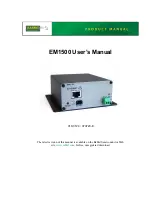
10
Specifications
10.1
Reactive power control
Reactive power can be used in electrical energy supply networks to bolster the level of voltage. As such, feed-in
inverters can contribute to statistical voltage stability. Reactive power brings about a voltage drop at the in-
ductive and capacitive components of the equipment which can either bolster or reduce the level of voltage. If
the generating plant draws inductive reactive power while active power is being fed in, part of the voltage
swing caused by the active power feed can be compensated for by the supply of reactive power.
This reactive power mode and the respective control process are specified by the grid operator. If no control
process has been specified, then the system should be operated using a reactive power specification of 0%.
10.1.1 Operating power range depending on grid voltage
The device can be operated within the respective fixed voltage range provided. The maximum apparent power
is stated in the following table. In the event of undervoltage determined by the maximum continuous current
subject to the grid voltage.
Voltage - devices with U
N:
220 V /
380 V; 230 V / 400 V; 240 V / 415 V
Voltage - devices with U
N:
270V /
480V
Maximum apparent power [p.u.]
≥ 400
≥ 480
1.04
390
468
1.04
380
456
1.0
360
432
0.95
342
412
0.90
323
388
0.85
Tab. 5:
Maximum continuous apparent power depending on grid voltage
The following figures show the reactive power-active power operating range for devices with a nominal voltage
of U
N
220/380, 230/400, 240/415. Devices with a nominal voltage of 277/480 correspond to the first figure tak-
ing into consideration the voltage values in this table.
1
P [p.u.]
Q [P.u]
0,6
0,4
0,2
0
1
0,8
1,2
0,6
0,6
1
0,0
above 390V
at 380V
at 360V
at 340V
Fig. 42:
P-Q operating range for devices below 12 kVA with U
N
220/380, 230/400, 240/415V (Qmax=0.95Smax)
540
S [p.u. S
nom
]
U [V]
0,6
0,4
0,2
0
1
0,8
1,2
340
460
300
260
380
420
500
Over load capability
Nominal capability
OV
RT
Under voltage
derating
UVRT
Fig. 43:
Apparent power subject to grid voltage for devices below
12 kVA with UN 220/380, 230/400, 240/415V
10.1.2 Dynamics and accuracy
n all of the control methods described below the specified set value at the inverter’s connection terminals is
adjusted using a stationary deviation of the reactive power of maximum 2 % QN. This maximum deviation al-
ways relates to the specified value as reactive power.
If the power factor cos ϕ is specified in the control method, then the deviation relates to the reactive power
value brought about by the current power.
The transient response of the control methods are determined by a PT-1 filter. The settling time corresponds to
5 Tau, or in other words, achieving approx. 99 % of the final value of the PT-1 filter. Subject to the control
method selected, there are also other parameters that determine dynamic behaviour as described below.
10.1.3 Reactive power functions
The following functions for controlling the reactive power are implemented in the devices listed above:
– cos ϕ constant
Manual
Specifications | 10
KACO blueplanet 3.0 TL3 KACO blueplanet 4.0 TL3 KACO blueplanet 5.0 TL3 KACO blueplanet 6.5 TL3 KACO
blueplanet 7.5 TL3 KACO blueplanet 8.6 TL3 KACO blueplanet 9.0 TL3 KACO blueplanet 10.0 TL3
Page 55
EN















































